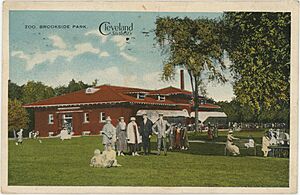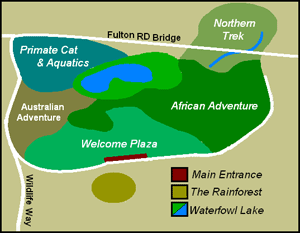Cleveland Metroparks Zoo facts for kids
 |
|
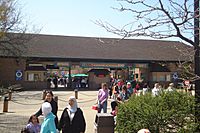
Cleveland Metroparks Zoo Entrance
|
|
| Date opened | 1882 |
|---|---|
| Location | Cleveland, Ohio, United States |
| Land area | 183 acres (74 ha) |
| Coordinates | 41°26′49″N 81°42′43″W / 41.447°N 81.712°W |
| No. of animals | 3000 |
| No. of species | 600+ |
| Annual visitors | 1.32 million (2023) |
| Memberships | AZA |
The Cleveland Metroparks Zoo is a large zoo in Cleveland, Ohio, covering 183 acres. It is home to over 3,000 animals from more than 600 different species. The Zoo is divided into several exciting areas, like the African Savanna, Australian Adventure, and The RainForest. It is also known for having one of the biggest collections of primates in North America. The Cleveland Metroparks Zoo is a popular place to visit all year round, with 1.32 million visitors in 2023.
Contents
History of the Zoo
The Cleveland Metroparks Zoo first opened in 1882. It was originally called the Cleveland Zoological Park. At first, it was located in Wade Park, where the Cleveland Museum of Art is today. Back then, the Zoo only had animals that lived in the local area.
In 1907, the city of Cleveland moved the Zoo to its current spot in Old Brooklyn. This is when the Zoo got its very first elephant! For many years, people often called it the Brookside Zoo. In the 1910s, new exhibits were built, including Monkey Island and pools for sea lions. By 1940, the Zoo had three elephants.
Between 1955 and 1975, the Zoo grew a lot. However, it faced challenges like flooding. In 1959, a flood caused the Zoo to lose its reptile collection and some buildings. The Zoo recovered by 1962, but it did not have a permanent reptile collection again until The RainForest opened much later.
The Zoo continued to expand with new buildings and exhibits. Construction started on the Primate & Cat Building in 1975. The Aquatics section was added in 1985. Later, The RainForest opened in 1992, Wolf Wilderness in 1997, and Australian Adventure in 2000. More recently, Asian Highlands opened in 2018, and The Rhino Reserve was completed in 2020. Susie's Bear Hollow opened in 2023.
Key Dates in Zoo Development
Here are some important dates for the Zoo's exhibits and buildings:
- 1882: The Cleveland Zoological Park first opens.
- 1907: The Zoo moves to its current location.
- 1934: Monkey Island is finished.
- 1956: The Pachyderm Building is built.
- 1970: Wade Hall is moved to its spot by Waterfowl Lake.
- 1975: Work begins on the Primate & Cat Building.
- 1985: The Aquatics part is added to the Primate & Cat Building.
- 1992: The RainForest is completed.
- 1997: Wolf Wilderness opens.
- 2000: Australian Adventure is completed.
- 2004: The Sarah Allison Steffee Center for Zoological Medicine opens.
- 2008: The Pachyderm building closes to make way for a new elephant area.
- 2011: African Elephant Crossing opens.
- 2015: Ben Gogolick Giraffe Encounter opens.
- 2016: Rosebrough Tiger Passage opens.
- 2018: Asian Highlands opens.
- 2019: Monkey Island is taken down to build the Rhino Reserve.
- 2020: Rhino Reserve opens.
- 2021: Eagle Zip Adventure opens.
- 2023: Susie's Bear Hollow opens.
Exploring the Exhibits
The Cleveland Metroparks Zoo is divided into different areas. Each area is designed to look like a specific part of the world. When you enter, you arrive at the Welcome Plaza. This area has buildings, a food court, and the Zoo's biggest gift shop. You can walk around the Zoo, or you can ride the "ZooTram." The tram takes visitors between the Welcome Plaza and the Primate, Cat & Aquatics Building.
The RainForest
The RainForest opened in 1992 and is one of the Zoo's most popular exhibits. It is a huge, two-story building with over 2 acres of space. This makes it one of the largest indoor tropical environments in the world! The RainForest is home to more than 10,000 plants and over 600 animals. These animals come from tropical places like Australasia, Africa, and the Americas.
The RainForest also brought back the Zoo's permanent reptile collection. This was the first one since the flood in 1959. You can see many reptiles and amphibians here. Some examples are Amazon milk frogs, Burmese pythons, dwarf crocodiles, Fiji banded iguanas, and different kinds of poison dart frogs.
The RainForest building is made of glass and granite. It has an outer ring with tropical plants, small mammal exhibits, a cafeteria, and a gift shop. The inner area holds the main animal exhibits. You can find animal habitats on both floors. The ground floor is called the "Lower Forest," and the second floor is the "Upper Forest."
When you enter, you'll see a 25-foot waterfall and feel warm, humid air. The building is kept at 80°F (27°C) all year. Around the waterfall, there's a lush garden with plants growing on trees and rocks. You can see different types of bromeliads, aroids, and orchids. The walls behind the waterfall look like ancient Mayan temple ruins. Here, you can see small New World monkeys like the pied tamarin and the endangered golden lion tamarin.
The RainForest also has a "Tropical Rain Storm" exhibit. It looks like a rainforest island with a big tree. A moat surrounds the island, filled with fish. Several times a day, a simulated thunderstorm happens. The lights dim, "lightning" flashes, and thunder rumbles. A "wall" of water streams down, showing what a tropical downpour is like. After the storm, fog fills the exhibit, creating a peaceful feeling.
The main animals in The RainForest are the Bornean orangutans. The zoo has five of them. You can also find animals like binturongs, red-rumped agoutis, and a large group of free-flying straw-coloured fruit bats. Other animals include giant anteaters, capybara, scarlet ibis, ocelots, clouded leopards, and fishing cats. There are also many smaller exhibits with insects, fish, and other reptiles and amphibians.
The Cleveland Metroparks Zoo announced that The RainForest closed permanently on September 9, 2024. This area will be updated and expanded to create a new "Primate Forest." This new habitat will be multi-story and will house gorillas and orangutans. The new Primate Forest is planned to open in 2026.
African Savanna
The African Savanna area is close to the Zoo's entrance. Here, you can see amazing animals like African lions, flamingos, giraffes, zebras, and eastern black rhinos. The African Elephant Crossing part of this area has elephants and meerkats. Baby rhinos, Lulu and Nia, were born here in 2018.
Sarah Allison Steffee Center for Zoological Medicine
The Zoo cares a lot about animal conservation. Because of this, they built the Steffee Center for Zoological Medicine in 2004. This center has medical, lab, and surgery rooms for animals. It also has a special ward and quarantine area. Its animal hospital has the first CT scanner used in a zoo hospital. Nearby, the Reinberger Learning Lab lets visitors learn about animal care. You can see interactive displays and even watch animal treatments happening through windows.
African Savanna and Giraffe Encounter
The African Savanna has several large yards for its animals. You can see Masai giraffes, Hartmann's mountain zebras, bonteboks, ostriches, and different kinds of African birds. In 2015, the Ben Gogolick Giraffe Encounter opened. Here, visitors can buy leaves to feed the giraffes, which is a very popular activity!
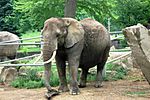
African Elephant Crossing
In 2011, the Zoo opened its new elephant exhibit, African Elephant Crossing. This amazing habitat cost $25 million. It made the elephants' living space four times bigger! This allowed the Zoo to have more African elephants, growing their herd from three to eight or ten. The exhibit has two large areas called the Savanna and the Mopani. These areas cover several acres and include deep ponds where the elephants can swim. Their sleeping areas are also much larger. Parts of the exhibit are heated so the elephants can be outside even in winter. Throughout the day, the elephants are guided across a path between their areas. This gives visitors a chance to see them up close! Besides elephants, this exhibit also introduced Meerkats, naked mole rats, and an African rock python.
Australian Adventure
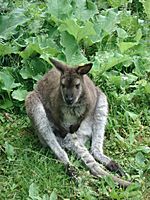
The Australian Adventure is an 8-acre exhibit designed to look like the Australian outback. Here, wallaroos, kangaroos, emus, and wallabies roam freely in an area called Wallaby Walkabout. You can also find dingoes here. During the summer, there are aviaries with birds like kea, cockatoos, and kookaburras. At Kookaburra Station, visitors can learn how sheep are sheared. In the Contact Yard, you can get close to Southdown sheep, goats, Alpacas, and other farm animals. The Australian Adventure also has a 55-foot Yagga Tree. This tree used to have animal exhibits and a fun snake slide for younger visitors. Because of Cleveland's cold winters, the Australian Adventure may be closed or have limited access in colder months.
Gum Leaf Hideout
Inside Koala Junction, the Gum Leaf Hideout is home to the Zoo's koalas and Matschie's tree-kangaroos. This exhibit also has interactive displays. They teach visitors about how cutting down trees affects Australian ecosystems.
Reinberger Homestead
The Reinberger Homestead looks like a traditional 19th-century sheep farm. It gives Zoo visitors a peek into Australian home life. The area has animatronic animals, like a koala and a kookaburra, that talk about Australian culture.
Wallaby Walkabout and Boomerang Railway
Wallaby Walkabout is designed to look like the Australian outback. It has winding paths that visitors share with kangaroos, Red-necked wallabies, and Common wallaroos from April to October. The area has plants that the animals can eat. Families can also take a train ride through the exhibit called the Boomerang Railway.
Yagga Tree
The Yagga Tree is an artificial, 55-foot-tall tree that looks like a Baobab tree. It is a main feature of the Australian Adventure. It once had exhibits for small animals and an animatronic crocodile named Wooly Bill.
Wilderness Trek
The Wilderness Trek area is where you'll find animals that like cold climates. These include Siberian tigers, grizzly bears, Tufted deer, Reindeer, and Red-crowned cranes. These animals stay active outdoors all year. The California sea lion and harbor seal exhibits have large pools where visitors can watch the animals play. The Zoo also has one of the largest collections of bear species in North America. You can see grizzly bears, Andean bears, Malayan sun bears, North American black bears, and sloth bears. In 2019, a sloth bear cub named Shala was born, the first in 30 years!
Wolf Wilderness
Wolf Wilderness lets visitors explore the environment of a northern forest. The Wolf Lodge is the main building here. It is an education and viewing center for gray wolves, beavers, and other wetland animals. Wolf Wilderness is one of the main North American habitats at the Zoo. It opened in 1997. It includes the Wolf Lodge, a large wooded area for the wolves, a 65,000-gallon pond, and viewing rooms.
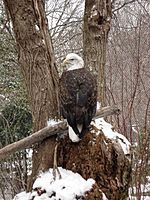
You enter the exhibit through the Wolf Lodge. This 3,000-square-foot building looks like a 19th-century fur trading post. Inside, you'll find information about animals from North America's forests and wetlands. This room leads to two main exhibit areas.
The first room is for the six Mexican gray wolves. You can watch them through large, floor-to-ceiling windows that look into their huge wooded habitat. Cameras in their enclosure show the wolves on monitors in the viewing room, so you can see them even when they are far away.
The viewing room leads to the wetlands and wolf display room. Here, you can see both the wolves and other North American animals through big windows. The main exhibits in this room are the Canadian beaver habitat, the 65,000-gallon freshwater pond, and the Zoo's bald eagles. The beaver habitat has an artificial beaver dam with windows. These windows let you see inside the beavers' nest! The pond is next to the viewing windows, like an aquarium. It shows what a wetland pond looks like underwater. The pond has many fish that live in North American wetlands.
Rosebrough Tiger Passage
Opened in June 2016, this exhibit has four separate, connected habitat areas for the Zoo's Amur tigers. It also includes two elevated pathways that go over your head!
Asian Highlands
Asian Highlands opened in June 2018. This exhibit has bigger habitats for snow leopards, Amur leopards, and red pandas. It also includes Sichuan takins. In April 2018, three snow leopard cubs were born here!
Susie's Bear Hollow
Susie's Bear Hollow opened in August 2023. This exhibit is home to the Zoo's sloth bears and spectacled bears. It replaced older enclosures with modern habitats for the Zoo's tropical bears.
Primate, Cat & Aquatics
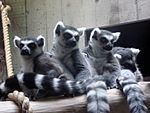
The Primate, Cat & Aquatics Building first opened in 1975 as the Primate & Cat Building. It has one of the largest collections of primate species in North America. You can see western lowland gorillas, Müller's gibbons, Allen's swamp monkeys, and many types of lemurs like Ring-tailed lemurs and Red ruffed lemurs. Next to the gorillas, there's a nocturnal section with animals that are active at night. These include Aye-ayes and Pygmy slow lorises. Other animals in this section that are not primates include Fossas. Not all of the Zoo's primates are in this building; some are in The RainForest and African Savanna.
In 1985, the Cleveland Aquarium closed. It gave its collection of exotic fish and invertebrates to the Metroparks Zoo. A part of the Primate & Cat building was updated to create the new Aquatics section. This section now has 35 salt and freshwater exhibits. You can see Australian lungfishes, a giant Pacific octopus, electric eels, and hundreds of living coral.
The Primate, Cat & Aquatics Building also has outdoor exhibits. These include outdoor areas for the gorillas. The Zoo's slowest residents, the Aldabra giant tortoises, can be found across from its fastest resident, the cheetah. Some of the tortoises are over one hundred years old!
Waterfowl Lake
The shallow, marshy areas of Waterfowl Lake are home to Chilean flamingos, Black swan, and trumpeter swans. In the summer, Müller's gibbons and lemurs live on the lake's islands. They use ropes above the water to move between them. You can see birds of prey like Andean condors and Steller's sea eagles in tall outdoor flight cages on the lake's eastern shore. The nearby Public Greenhouse has hundreds of tropical plants and a seasonal butterfly exhibit. Waterfowl Lake is also where Wade Hall is located. This is one of the oldest zoo buildings in North America. Today, Wade Hall is a Victorian ice cream parlor.
Zoo Recognition
The Cleveland Metroparks Zoo is one of five city zoos in Ohio. Ohio is sometimes called a "Zoo State" because it has so many great zoos, almost as many as California!
In 2014, USA Today ranked the nation's zoos. The Cleveland Metroparks Zoo was nominated for a USA Today award. Three other Ohio zoos also won awards for the 'Best US Zoo' contest: the Columbus Zoo and Aquarium, the Cincinnati Zoo and Botanical Garden, and the Toledo Zoo.
Famous Animals
Balto
Balto was an Alaskan husky and sled dog. He became famous for leading the last part of the 1925 serum run to Nome. Balto lived at the Cleveland Zoo from 1927 until he passed away in 1933. Balto and six of his teammates were bought by the people of Cleveland after a fundraising campaign. After he died, Balto's body was preserved by the Cleveland Museum of Natural History. You can still see him there today! Statues of Balto and Togo, another heroic dog from the serum run, were put up at the Zoo in 1997.
Timmy the Gorilla
Timmy the Western lowland gorilla is one of the most famous animals in the Cleveland Metroparks Zoo's history. He became very well-known for having many babies at the Bronx Zoo. Timmy lived indoors at the Cleveland Zoo for 25 years. Then, he was sent to the Bronx Zoo to help with breeding programs. This move was very debated. Animal rights groups protested the idea of separating Timmy from his companion, Kate. This even led to a federal court case.
Timmy went on to have more than 13 babies in New York. Many of them were born in the Bronx Zoo's Congo Gorilla Forest exhibit. One of Timmy's offspring, Okpara, was born at the Bronx Zoo. Okpara later came to Cleveland before moving to another facility.
Blackie the Hippo
On January 13, 2014, the Zoo's Nile hippopotamus named "Blackie" was humanely euthanized. He was about 60 years old. Blackie was born in the wild in 1953. He lived at the Zoo's Pachyderm Building from 1955 until 2008. For the rest of his life, he lived in a private barn. When he passed away, Blackie was believed to be the longest-lived male Nile hippopotamus ever recorded in human care in North America. He was known for being gentle and weighed about 3,700 pounds.
Aldabra Tortoises
The Zoo cares for three tortoises. Two of these amazing animals are over 100 years old!
Programs and Events
Education and Learning
The Cleveland Metroparks Zoo offers day and overnight camps for kids aged 5 to 14 during the summer. The Summer Day Camp teaches children about conservation and helps them understand the natural world. Overnight camps include stays in the Australian Adventure's Reinberger Homestead. Guests can also stay in the Wolf Lodge and use tracking technology like real scientists. The "Rising Waters Safari Camp" lets campers stay in the Zoo's African Savanna for a safari experience with animal encounters. All overnight programs combine elements of different cultures with a focus on conservation.
The Zoo also has a "Keeper for a Day" program. This is for middle school, high school, and college students who are interested in working with animals. Participants spend a day with animal professionals. They help prepare meals, clean enclosures, do training exercises, and give animals fun items to keep them busy.
Helping Conservation
The Zoo provides grants to support research and conservation projects around the world. In 2011, the Zoo helped fund over 90 conservation projects in 39 countries. These projects included helping elephants in southern Africa and studying gorillas in central Africa. They also supported efforts to stop poaching of freshwater turtles. Over the past ten years, the Zoo has supported more than 600 conservation projects in almost 100 countries! Current efforts include "Quarters for Conservation" and raising awareness about the Palm Oil Crisis.
Special Events
Boo at the Zoo
The Zoo's yearly fall event, "Boo at the Zoo," happens in October. Visitors can see the cold-weather animals that are still outside. Everyone is encouraged to wear costumes! Boo at the Zoo is a safe Halloween option with animal shows, live performances, and other fall activities.
DINOSAURS!
During the summer, the Zoo often features prehistoric animals along the path around Waterfowl Lake. Younger visitors can dig for "fossils" and learn about paleontology, the study of ancient life. Past "DINOSAURS!" exhibits have shown animatronic dinosaurs from around the world. These included Tyrannosaurus rex, Stegosaurus, Triceratops, and many more!
Renting Event Spaces
In Spring 2015, the Zoo opened a new event center called Stillwater Place. It has beautiful views of Waterfowl Lake and can hold up to 300 guests. Stillwater Place is open all year for weddings, birthdays, reunions, and other special occasions.
Incidents
In 1938, a polar bear named "Silver" pulled a young artist into its enclosure. The artist was injured. Other artists saw what happened and tried to help. For several years after, some Zoo visitors would throw things at "Silver" because of the incident. In 1940, a 10-year-old girl even sent money to the Zoo to protest people throwing things at the bear.
In 2015, a child accidentally fell into a cheetah exhibit. The child's parents were able to get him out, and he was taken to the hospital.


